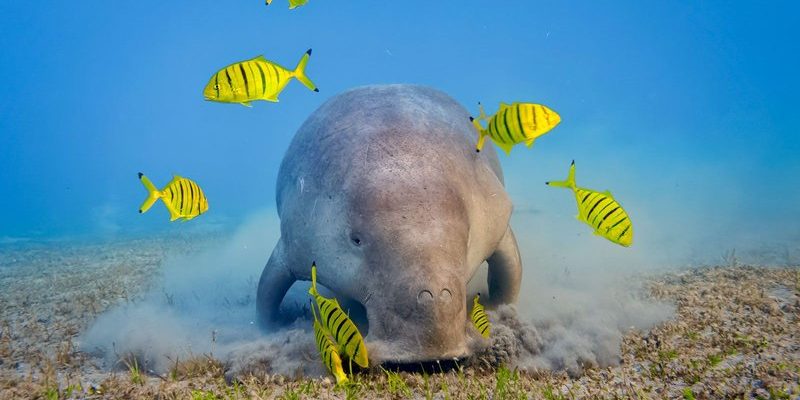
In the world of dugongs, the bond between mother and calf is essential for survival. Here’s the thing: dugongs have a long gestation period, lasting about 13 to 14 months. That’s a long time to carry a baby in the ocean! Once born, the calves depend heavily on their mothers for food, safety, and guidance. Let’s dive into the nitty-gritty of how dugongs raise their young in the wild.
The Life Cycle of Dugongs
Dugongs reach sexual maturity between the ages of 8 to 18 years, depending on their environment and conditions. Once mature, they typically mate in shallow waters. Copulation can occur year-round, but there seems to be a peak mating season in some regions, often coinciding with changes in water temperature. After a long gestation period, the mother finally gives birth to a single calf, usually measuring around 1 meter in length.
The calf is born tail-first to minimize the risk of drowning, which is crucial in the underwater world. After birth, the mother aids the calf to the surface for its first breath. That initial moment is vital as it sets the tone for the bond that will develop between them. The mother will stay close, helping the calf learn to swim and navigate the waters around them, providing a protective shield against predators and other dangers.
Feeding and Bonding
Dugong calves need a diet rich in seagrass, much like their mothers. At first, the mother will nurse her calf, providing nutrient-rich milk suited to the young dugong’s needs. This milk is crucial for growth and energy. A calf typically nurses for about 1 to 2 years, learning to graze on seagrass as it grows.
You might be wondering how the mother teaches her calf to eat. Honestly, it’s a mix of instinct and observation. The mother forages for food, and the calf watches closely, mimicking her actions. This learning process is similar to how human babies observe and imitate their parents. Over time, the young dugong picks up the skills necessary to thrive on its own.
Mother-Calf Interactions
The relationship between a mother dugong and her calf is filled with tenderness and support. Dugong mothers are known to exhibit behaviors that show they care deeply for their young. They often nuzzle their calves and stay very close, guiding them through the underwater world.
Interestingly, these interactions aren’t just about survival; they also play a role in social learning. The mother communicates with her calf using a variety of sounds and body gestures, which helps the calf develop social skills that are essential for interacting with other dugongs later in life. You can almost picture the mother showing her calf the ropes, much like a parent teaching their child about the world.
Safety and Protection
In the wild, safety is a top priority for a mother dugong. Predators like sharks and orcas pose a constant threat, and a mother must remain vigilant to protect her calf. Dugongs often choose to stay in shallower waters, where the risk of encountering these predators is lower.
When an approaching threat is detected, the mother may use her body to shield the calf, providing a sense of security. It’s akin to how we protect our loved ones by putting ourselves in harm’s way. This instinctual behavior highlights the deep bond formed during the formative years of a dugong’s life.
Challenges Faced by Dugongs
Despite their nurturing ways, dugongs face numerous challenges in the wild. Habitat loss due to coastal development and pollution has significantly impacted their living conditions. The decline of seagrass beds means fewer food sources for both mothers and calves. Additionally, boat strikes and fishing nets can lead to injuries or fatalities, posing a dire threat to their population.
Dugongs are listed as vulnerable species, which emphasizes the need for conservation efforts. Protecting their habitats and ensuring a healthy ecosystem is crucial for their survival and is something we all can contribute to.
The Role of Conservation Efforts
Conservation efforts play a vital role in ensuring the future of dugongs and their young. Various organizations work tirelessly to protect their habitats, establish marine protected areas, and promote policies to reduce human impact on their environment.
Public awareness is also essential. When communities understand the importance of dugongs and their need for healthy ecosystems, they’re more likely to support conservation initiatives. You might even consider getting involved in local efforts or advocating for marine conservation to help ensure a bright future for these gentle creatures.
Dugongs raising their young is a beautiful testament to the nurturing side of nature. From long gestation periods to protective behaviors, these creatures showcase remarkable parenting skills in the wild. However, as challenges arise from environmental threats, it’s more important than ever to support conservation efforts designed to protect dugongs and their habitats.
By understanding how dugongs raise their calves and the struggles they face, we can all play a part in helping these gentle giants thrive. Let’s work together to ensure that future generations can enjoy the sight of dugongs gracefully gliding through our oceans, nurturing their young just like they have for thousands of years.

